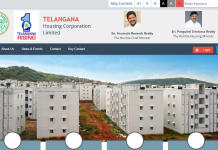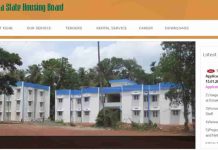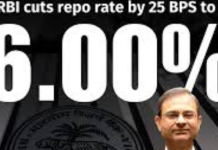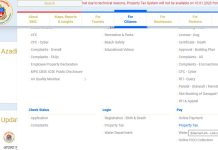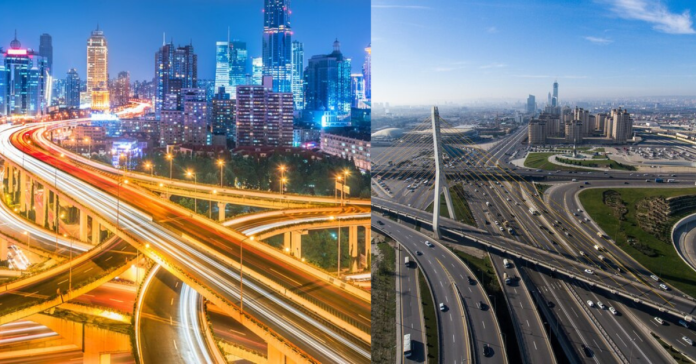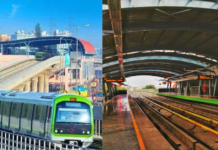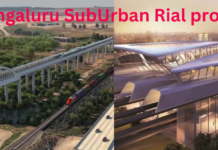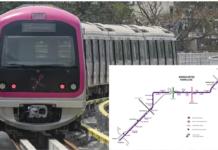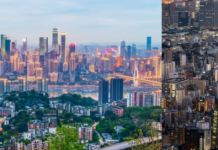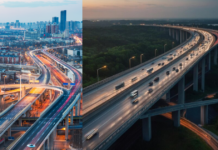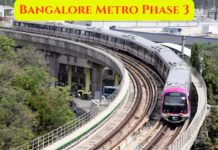The Satellite Town Ring Road (STRR), a massive infrastructure project underway in Bangalore, promises to revolutionize traffic flow and connectivity within the city and surrounding areas. This project is a transformative infrastructure initiative designed to enhance connectivity and spur economic development around major metropolitan areas
Project Overview
The Satellite Town Ring Road (STRR) is an ambitious road project aimed at creating a seamless and efficient transportation network around Bengaluru, Karnataka. The primary objective of the STRR is to connect various satellite towns around the city, reducing congestion within the metropolitan area and promoting balanced regional development.
Project Details:
- Length: The total length of the STRR upon completion will be approximately 280.8 kilometers (174.5 miles).
- Lanes: The road will be a 4 to 6-lane expressway, designed for a maximum speed of 100 kilometers per hour (62 mph).
- Owner: The National Highways Authority of India (NHAI) is overseeing the project’s development under the Bharatmala Pariyojana initiative.
- Estimated Cost: The total project cost is estimated to be around Rs. 17,000 crore (US$2.1 billion).
Distance and Connections
The STRR spans approximately 280 kilometers, encircling Bengaluru and connecting several key satellite towns and suburban areas. The major towns and areas linked by the STRR include:
- Dobbspet: An industrial town to the northwest of Bengaluru.
- Doddaballapur: Known for its textile industry and educational institutions.
- Devanahalli: Home to Kempegowda International Airport.
- Hoskote: A growing industrial and logistics hub.
- Sarjapur: A rapidly developing residential and commercial area.
- Attibele: Known for its industrial estates and proximity to Tamil Nadu.
- Anekal: A major satellite town with industrial and residential growth.
- Kanakapura: A town with significant tourism and agricultural activities.
- Ramanagara: Famous for its silk industry and granite production.
- Magadi: Known for its historical significance and growing urbanization.
The STRR is designed to seamlessly integrate with the existing road network, including major highways such as NH44, NH75, NH209, and NH648, enhancing inter-city connectivity and reducing travel time.
Route Map 2024
As of 2024, the Satellite Town Ring Road is expected to be a well-defined and operational route encircling Bengaluru. The projected route map for 2024 includes key segments and junctions as follows:
- North Segment:
- Starts at Dobbspet, connecting NH44, and moves eastward towards Doddaballapur.
- Continues to Devanahalli, providing direct access to Kempegowda International Airport.
- East Segment:
- From Devanahalli, the route extends southwards, connecting Hoskote and intersecting NH75.
- Continues to Sarjapur, linking various industrial and residential areas.
- South Segment:
- Extends from Sarjapur to Attibele, intersecting NH44 and providing connectivity to Hosur in Tamil Nadu.
- Proceeds to Anekal, enhancing access to industrial zones.
- West Segment:
- From Anekal, the route moves towards Kanakapura, intersecting NH209.
- Continues to Ramanagara, linking NH44, and finally reaches Magadi, completing the ring by connecting back to Dobbspet.
Completed Phases
1. Dobbaspet-Doddaballapur Section:
- Length: 42 km
- Completion Date: March 2024
- Key Features: This section has already shown positive effects on traffic management and connectivity in the covered areas. It includes state-of-the-art tolling systems and infrastructure designed to handle high traffic volumes efficiently.
2. Doddaballapur-Hoskote Section:
- Length: 34.15 km
- Completion Date: November 2023
- Key Features: This segment is fully operational and features a boothless toll plaza that utilizes FASTag for seamless toll collection, enhancing the efficiency and reducing delays. This section has a capacity to handle up to 10,000 Passenger Car Units (PCU) per hour.
Also read: Chennai Bengaluru corridor project
Toll Fee Details at Hulimangala and Nalluru-Devanahalli Toll Plazas
Starting on Friday, June 14, the National Highways Authority of India (NHAI) will start collecting toll fees for the entire stretch of the Satellite Town Ring Road (STRR) from Dabaspet to Hoskote.
Hulimangala Toll Plaza
| Category | Single Journey (₹) | Return Journey Within a Day (₹) | Monthly Pass (50 Journeys) (₹) |
|---|---|---|---|
| Car/Jeep/LMV | 105 | 155 | 3,490 |
| LCV/LGV/Minibus | 170 | 255 | 5,635 |
| Truck/Bus (2-axle) | 355 | 530 | 11,805 |
| 3-axle commercial vehicles | 385 | 580 | 12,880 |
| Heavy construction machinery/earth moving equipment | 555 | 835 | 18,515 |
Nalluru-Devanahalli Toll Plaza
| Category | Single Journey (₹) | Return Journey Within a Day (₹) | Monthly Pass (50 Journeys) (₹) |
|---|---|---|---|
| Car/Jeep/LMV | 80 | 120 | 2,720 |
| LCV/LGV/Minibus | 130 | 200 | 4,395 |
| Truck/Bus (2-axle) | 275 | 415 | 9,095 |
| 3-axle commercial vehicles | 300 | 450 | 10,040 |
| Heavy construction machinery/earth moving equipment | 435 | 650 | 14,435 |
Ongoing and Upcoming Phases
3. Phases 4-6 (Under Construction):
- Coverage: Additional 100 kilometers
- Expected Completion: Within the next 1-2 years
- Key Developments: These phases include crucial segments such as the Hoskote Road and Dobbaspet-Doddaballapur sections, which are vital for enhancing regional connectivity.
4. Phases 7-10 (Bidding Stage):
- Coverage: Remaining 60 kilometers
- Construction Start: Anticipated to begin soon after contractor selection
- Key Features: These final phases will complete the ring road, providing a comprehensive transportation solution for the region.
Key Areas Impacted by STRR
- Devanahalli
- Doddaballapur
- Hoskote
- Sarjapur
- Attibele
- Anekal
- Kanakapura
- Ramanagaram
- Magadi
Real Estate Trends and Developments Satellite Town Ring Road
1. Devanahalli
- Proximity to Airport: Devanahalli’s proximity to Kempegowda International Airport has already made it a sought-after destination. The STRR will further enhance its connectivity, making it an attractive location for residential, commercial, and industrial investments.
- Price Trends: Property prices have seen a significant rise due to improved connectivity and increased demand for residential and commercial spaces.
- Development Projects: Several residential projects, IT parks, and logistics hubs are being developed, catering to the growing demand.
2. Doddaballapur
- Industrial Growth: Known for its industrial estates, Doddaballapur will benefit from the STRR, which will ease transportation of goods and raw materials.
- Residential Expansion: The improved connectivity is encouraging residential developments, with many builders launching affordable and mid-segment housing projects.
3. Hoskote
- Residential Boom: Hoskote has emerged as a preferred residential hub due to its affordable housing options and proximity to IT corridors in Whitefield and Outer Ring Road.
- Infrastructure Development: The STRR will spur further infrastructure developments, including schools, hospitals, and shopping complexes.
4. Sarjapur
- IT Hub: Sarjapur is already a growing IT hub with several tech parks and offices. The STRR will reduce travel time to other parts of the city, making it even more attractive for IT professionals.
- Luxury Housing: There is a rise in luxury residential projects, catering to the affluent working population.
5. Attibele
- Affordable Housing: Attibele offers affordable housing options, attracting first-time homebuyers and investors.
- Industrial Corridor: The area’s industrial base will benefit from improved logistics and connectivity provided by the STRR.
6. Anekal
- Residential Growth: Anekal is seeing a surge in residential projects, including gated communities and plotted developments.
- Connectivity Boost: The STRR enhances connectivity to Electronic City and other IT hubs, increasing the area’s desirability.
7. Kanakapura
- Eco-Friendly Projects: Known for its greenery and serene environment, Kanakapura is attracting eco-friendly and sustainable residential projects.
- Tourism Potential: The area’s natural attractions will become more accessible, boosting tourism and hospitality sectors.
8. Ramanagaram
- Mixed-Use Developments: Ramanagaram is witnessing a mix of residential, commercial, and industrial developments.
- Logistics Hub: The STRR’s connectivity will enhance its potential as a logistics and warehousing hub.
9. Magadi
- Residential and Industrial: Magadi is experiencing growth in both residential and industrial sectors, driven by improved accessibility.
- Affordable Housing: The area is attracting affordable housing projects, making it a viable option for budget-conscious buyers.
Factors Driving Real Estate Growth
- Improved Accessibility: The STRR significantly reduces travel time between satellite towns and Bangalore, making these areas more accessible and attractive for residential and commercial development.
- Infrastructure Development: The enhanced connectivity encourages the development of supporting infrastructure such as roads, public transport, schools, hospitals, and shopping centers.
- Economic Growth: The STRR is expected to boost economic activity by improving logistics and transportation efficiency, attracting businesses, and creating jobs.
- Investment Opportunities: The expected rise in property values along the STRR corridor presents lucrative investment opportunities for both developers and buyers.
Future Prospects
- Sustained Growth: The ongoing and upcoming phases of the STRR will continue to drive real estate growth, with new areas being developed and existing ones seeing further appreciation in property values.
- Smart City Initiatives: Integration with smart city initiatives will enhance the livability and attractiveness of these regions, promoting sustainable and intelligent urban development.
- Commercial Hubs: The development of commercial hubs along the STRR will create new business districts, attracting corporate offices and retail developments
Why Invest Around the STRR?
Strategic Importance: The STRR is a key infrastructure project that enhances Bangalore’s connectivity with its surrounding regions, promoting economic growth and regional development.
Market Potential: The areas around the STRR are poised for significant appreciation in property values, driven by improved accessibility and infrastructure development.
Government Support: The project has strong governmental backing, ensuring steady progress and support for ancillary developments, which in turn boosts investor confidence.
Diverse Opportunities: The STRR provides diverse investment opportunities across residential, commercial, and industrial segments, catering to various investor profiles and risk appetites.
Long-Term Returns: The strategic location and developmental focus around the STRR make it a lucrative option for long-term real estate investments, promising steady appreciation and high returns.
Also read: Chennai Bengaluru corridor project
Benefits of Investing Around STRR
1. Enhanced Connectivity
- Reduced Travel Time: The STRR significantly reduces travel time between Bangalore and its satellite towns, making these areas more attractive for residential and commercial developments.
- Accessibility: Improved road infrastructure enhances access to key business districts, IT parks, industrial zones, and the international airport, boosting the appeal of nearby real estate.
2. Appreciation of Property Values
- Increased Demand: As connectivity improves, the demand for residential, commercial, and industrial properties is expected to rise, leading to appreciation in property values.
- Early Mover Advantage: Investing in the early stages of STRR development can yield higher returns as property prices are lower initially and tend to increase as the project progresses.
3. Economic Growth and Job Creation
- Business Opportunities: The STRR facilitates better logistics and transportation, attracting businesses and industries to set up operations, which in turn creates job opportunities and boosts the local economy.
- Regional Development: The influx of businesses and improved infrastructure promotes balanced regional development, leading to the establishment of new markets and commercial hubs.
4. Quality of Life Improvements
- Residential Appeal: Improved connectivity and infrastructure lead to the development of better residential communities with enhanced amenities, attracting more residents.
- Social Infrastructure: Enhanced road networks encourage the development of schools, hospitals, shopping centers, and recreational facilities, improving the overall quality of life.
5. Diversified Investment Opportunities
- Mixed-Use Developments: The STRR promotes mixed-use developments that combine residential, commercial, and recreational spaces, offering diverse investment opportunities.
- Flexible Options: Investors can choose from a range of property types, including apartments, villas, office spaces, retail outlets, and industrial warehouses.
6. Sustainability and Smart Development
- Green Projects: The focus on sustainability and smart city initiatives around the STRR ensures that new developments are eco-friendly and equipped with modern amenities.
- Future-Proof Investments: Properties in these regions are likely to be more resilient to future urban challenges, given the emphasis on sustainable planning and infrastructure.
In conclusion, the STRR project offers a multitude of benefits and opportunities for real estate investors. By adopting a strategic investment approach and leveraging the potential of this transformative infrastructure project, investors can achieve significant returns and contribute to the balanced development of the Bangalore metropolitan region.
Frequently Asked Questions:
The Satellite Town Ring Road (STRR) is a massive infrastructure project under construction in Bangalore. It’s designed to improve traffic flow and connectivity between the city and surrounding areas.
Reduced travel times between Bangalore and satellite towns.
Improved accessibility for businesses and logistics.
Increased demand for residential and commercial real estate along the corridor.
Potential for development of new satellite towns
The STRR is being built in phases.
Some sections are already operational, with an 80-kilometer stretch inaugurated in March 2024.
Phases 4-6 are under construction and expected to be completed within the next 1-2 years.
Phases 7-10 are in the pre-construction stage with contractor bidding underway.
Suggested Article:
Chennai Bengaluru Industrial Corridor Project: Complete Guide 2024
Pune Bangalore Expressway: Complete Guide & latest updates 2024
Baiyappanahalli Metro Station Bangalore: Route map, Timings and Real estate






